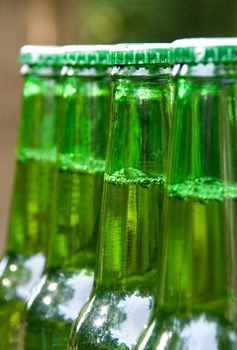Aug 19 2009
Grolsch (Netherlands) wanted to launch a newly designed bottle, but wanted to be clear about the subsequent costs which would be involved from having to sort the bottle out from the Netherlands' standard bottles during the recycling process. Dutch consumers return empty bottles to their shops which in turn pass them back to the breweries for re-use.

Based on consumer behaviour studies with respect to returning crates filled with bottles to shops, and on the assumption that the percentage of Grolsch bottles in the crates on the top layer of the pallet represent the percentage of Grolsch bottles in the entire pallet, Grolsch chose a small German company called Syscona to develop a technical solution that could measure the number of Grolsch bottles (per pallet) in order to keep the sorting costs as low as possible. Calculations indicated that only pallets containing more than X "foreign" bottles needed to be sorted; other pallets could be sent to the filling lines directly from the empty goods warehouse.
Determined to search for a breakthrough invention which could be used throughout the industry, the pair turned to EUREKA and the German Federation of Industrial Research Associations for help with funding.
Syscona and Grolsch quickly completed the first stage of the project, concluding from a study that the Dutch generally didn't mix up their different brands of empty bottles, meaning building a new sorting line at Grolsch would be a waste of up to 8 million euros. The pair worked out that pallets which had a limited number of rogue bottles could be sent on to the brewery's normal production line which wouldn't fill them up with Grolsch beer. "After a certain level of non-Grolsch bottles, too much disruption to the line would be caused and that would be inefficient," Ladrak-Keppels says.
So Syscona began developing a machine which could identify bottles in crates on the top layer of a pallet- even without being able to see more than the top of 240 bottles and the pallets sides. If Grolsch's new bottles could be identified, as well as its other Grolsch bottles and unwanted bottles from other brands, the machine could be programmed to send pallets with none/few rogue bottles straight onto the production line and to send those which needed sorting to another area where workers could manually remove the unwanted bottles.
In July 2007, the machine was completed and successfully tested. A week later, a four-month pilot was started at Grolsch where the machine identified bottles with a 99 percent reliability rate. "We are the first company to be able to detect the content of a whole pallet," says Spiegelmacher. A satisfied Grolsch now has two machines working on its lines and Syscona has sold some of the technology developed in the project to several German brewers which are using them to identify bottles on crates.